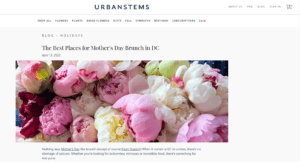Babylist marketers are expected to use generative AI to assist their campaigns.
Babylist, an online marketplace and baby registry aggregator, treats generative AI as a “co-pilot,” and not necessarily a time-saving tool, says Lee Anne Grant, chief growth officer.

Lee Anne Grant, chief growth officer, Babylist
“It’s a tool to help generate ideas, content and copy,” she says. “In some ways, using it is taking us more time.”
This is because Babylist’s creative team uses the technology to inspire rather than outright write complete blog posts or other marketing content. Marketers ask AI questions and then think about how the results can help them create.
“We had an all-hands meeting [in early 2023] with the goal to approach the technology in an educational development way,” Grant says. “You’re not only allowed to use it for your job, but you’re also expected to.”
More retailers are likely to follow suit as the technology continues to advance and retailers learn how to wield it. 56% of U.S. marketing or advertising decision-makers already use generative AI in their marketing efforts, according to consulting firm Forrester Research Inc.’s June 2023 business-to-consumer marketing survey of 154 executives. These large language models, chatbots and image generator vendors include ChatGPT, DALL-E, Stable Diffusion and Midjourney.
Digital marketers are learning that the more they test, the more the technology learns. This affordable tool can help — but not replace — marketers. Babylist uses ChatGPT to test copy for newsletter and marketing email campaigns. Online florist UrbanStems uses generative AI to write blog posts, and it creates images for social media marketing creative. And men’s footwear brand Koio uses AI-generated copy for brainstorming email and ad ideas. The costs are low, and retailers like UrbanStems are mindful that if they aren’t using it, their competition certainly is.
Retailers must consider the potential upsides — and pain points — when using generative AI
Digital marketers are using generative AI to draft ideas and examples for emails, SEO and other marketing materials. While the potential benefits are vast, there are also concerns, says Jay Pattisall, vice president, principal analyst at Forrester.
Marketers must consider how brands, retailers and agencies are using the technology, Pattisall says. Copyright law does not protect AI-generated art, for example.
But the potential for how brands can use AI is exciting, he says. Advertising agencies are building platforms for their clients as part of their own proprietary technology. Retailers are building in-house, too, he adds.
“But at this stage, it’s more practical to buy because there are more options available on the marketplace. That may change in the future,” he says.
Babylist tests ChatGPT-generated email campaigns
Babylist uses ChatGPT to test newsletter marketing email campaigns. In 2023, Bed Bath & Beyond Inc., owner of major baby products retail chain Buy Buy Baby, filed for bankruptcy. Babylist saw this as an opportunity to acquire Buy Buy Baby’s customers.
Babylist ran a test for an email marketing campaign on April 29 with ChatGPT for its two newsletter audiences. It sent out one test to 10% of its “pregnant” newsletter recipients (about 59,000 subscribers out of 589,000 on the total list) and 10% of its “parent” newsletter recipients (222,000 recipients of 2.32 million). Half of each group received one email written by a Babylist editor and the other written by ChatGPT.
The results? For the pregnant group, the editor’s email won with a 2.9% higher open rate compared with the generative AI’s version.
- The Babylist editor’s subject line: “buybuy BABY Bankruptcy & Your Registry: What to Know.”
- The ChatGPT’s subject line: “What the buybuy BABY Bankruptcy Means for Parents.”
For the parent group, ChatGPT gained a slight edge over the human editor with a 0.37% higher open rate.
- The Babylist editor’s subject line: “buybuy BABY Bankruptcy & More Parent News.”
- The ChatGPT’s subject line: “What the buybuy BABY Bankruptcy Means for Parents.”
Babylist found that ChatGPT-generated subject lines increased open rates in half of their tests. It concluded that ChatGPT is a “great resource for when the team needs subject line inspiration or help writing one,” Grant says.
AI helps retailers brainstorm ideas
ChatGPT-generated content helps Babylist’s creative team create better content, Grant adds. The value is in the brainstorming.
“If a copywriter is feeling stuck on a new concept for TikTok video, they can ask ChatGPT to generate a bunch of ideas,” she says.
Using generative AI allows retailers to scale and personalize marketing based upon the brand’s approach, says Forrester’s Pattisall.
“Let the people be in charge of the creativity and let the machines help scale and volumize the marketing,” Pattisall says.
Retailers must consider copyright and liability issues
Babylist employees are instructed not to share proprietary or confidential information with ChatGPT or any other public generative AI platform, Grant says.
This is important because retailers must also take care about what materials they use to “train” the AI model, Pattisall says.
“If those inputs are using data points that are copyrighted material, then the model potentially is violating the copyright by using rights-protected materials,” he says.
One example of this is between visual media company Getty Images and Stability AI Inc. Getty Images accused Stability AI of using more than 12 million photos without permission or payment to use those images. The complaint, filed in February 2023, says that Stability AI unlawfully used Getty’s copyrighted images and text, including metadata, to train its AI text-to-image tool Stable Diffusion.
Metadata is the information used to summarize how and when the data was created as well as the source, type and owner of the data. Stable Diffusion is a text-to-image model that uses deep learning to generate high-quality images from written descriptions.
“All of Getty’s images are copyrighted images,” Pattisall says. “So the liability is a concern for marketers.”
UrbanStems jumps onto generative AI to keep up with competitors
Competition prompted online flower retailer UrbanStems to focus on generative AI, says Katie Hudson, content director. In early 2023, the retailer was already using generative AI to create notes to accompany its flowers. Hudson says she noticed competitors doing the same — and she read about it in the media.

Katie Hudson, brand marketing and content, UrbanStems
UrbanStems decided to look into how it could use the technology beyond brand awareness, Hudson says.
Mother’s Day is UrbanStem’s busiest holiday. It accounts for 15% of the retailer’s total annual revenue. For Mother’s Day 2023, the retailer used ChatGPT to write a blog about the 10 best brunch spots for Mother’s Day in Washington, D.C.
UrbanStems marketers wrote the introduction, AI wrote the rest of it, and the article appeared in the retailer’s blog section on its website.
“During May, which includes Mother’s Day, we saw this local post drive 5% of our organic blog traffic. It was in our top 10 performing posts for the month,” Hudson says.
Blogs are not intended to drive conversion, but rather, improve organic search results, she says.
“Our blog had our highest ever non-brand search traffic during Mother’s Day,” Hudson says.
This could be attributed to the brunch blog, among other marketing efforts, she says. Over the two weeks leading up to Mother’s Day, UrbanStems’ organic search’s conversion rate increased 17%, she says.

UrbanStems used AI to write a top 10 best brunch spots for Mother’s Day in Washington D.C. in April 2023. The post increased organic blog traffic 5% in May. It was in the top 10 performing blog posts of the month.
UrbanStems has not drafted enough generated-AI posts on its blog to truly compare performance, Hudson says. Part of the reason is because it typically takes several months for its blogs to gain traffic and views in search engines like Google, she says.
Digital marketers use AI to automate content creation tasks
Not only did this ChatGPT-post drive traffic to its site, but it saved its marketers time as they did not have to manually research brunch places.
The retailer is drafting at least one AI-generated blog post a week to test how the posts perform, Hudson says. UrbanStems marketers use templates to help guide the AI. Marketers can use saved templates and copy and paste information like name insert and word count requirements, she says.
“We don’t have to do everything from scratch,” Hudson says.
What’s left is copyediting.
“I find where it’s saving us time is truly the structure of the blog. It builds it out. We give it all the key questions you might want answered and it will give us some interesting facts. We then go in and tweak as needed,” Hudson says. “Instead of a blog post taking a couple of hours, it will take 20 minutes.”
AI results need human assistance
The AI results aren’t perfect, as sometimes the AI will make up descriptions for products it does not know, or it will not write in the tone UrbanStems’ brand voice, Hudson says.
“We asked ChatGPT to write about a bouquet with a certain kind of flower and the description was way off. It didn’t know our products at all,” Hudson says, without revealing more. “It was kind of guessing. So, we had to go back and do tweaks.”
UrbanStems is feeding ChatGPT its own product descriptions. This will help it better understand the tone of the “brand’s voice” as it learns, Hudson says.
“We’re still working on having AI understand our brand voice. AI tends to create cheesy writing [for descriptions],” she says.
So for now, UrbanStems is still writing its own product descriptions.
“We are using AI to draft all our SEO content, some of our blog content, and all our meta descriptions and title tags for SEO purposes,” she says.
Retailers use AI to generate marketing content
Babylist also uses generative AI for search engine optimization. The online marketplace uses Frase, a generative AI content writing software vendor.
Typically, marketers log into Google Webmaster Tools to search what to use for SEO, Babylist’s Grant says. Now, Frase generates frequently asked questions keywords that Babylist should use to make sure an article they’re writing is SEO-optimized, she says.
“That frees up our editors to take the time to write an article and create better quality content,” Grant says, without revealing more.
Forrester’s Pattisall says generative AI will allow retailers to send more relevant communication. Marketers can uncover new ways to grow and acquire new customers. They can also use the technology to keep existing customers at a cost that does not exponentially increase year after year, he says.
“[Retailers] can maintain their business margins,” he says “They can provide the type of marketing services that they’re good at in a way that doesn’t break the bank. [The technology] allows them to be profitable,” he says.
Generative AI produces images for social media
Another way marketers can use generative AI is to create images. UrbanStems uses AI software program Midjourney that creates images from text prompts. Marketers ask it to create an image of a 10-stem red and white arrangement of peonies, in a glass vase on a white background.
Hudson says the results were encouraging.
“While it still looked like AI — not quite like a true image — it was a great starting off point,” Hudson says. “I sent that off to the merchandising team and they were able to use that image for vendors to use as a reference. That’s a huge value to us.”
AI-generated images allow UrbanStems to experiment and create new bouquet designs quickly. They do not have to buy the flowers and conduct a photo shoot to mock up new designs, she says.
Hudson says the retailer uses the standard tier of Midjourney, which means it has limits on how many images it can have the AI create in a month. Businesses can also pay more to have the AI generate images in seconds or create images in 10 minutes for cheaper. A basic plan can cost $10 a month to $120 per month for a mega plan.

UrbanStems uses Midjourney to create images of flower arrangements to use as product mock ups to share with vendors.
Using generative AI to generate social media images
During the summer of 2023, UrbanStems ran a test via social media to see if it could gain consumers insights using AI generated images.
The test used products UrbanStems already sells, but the goal was to see if it could gain insights before actually creating new products.
The retailer launched “This or That” polls using Instagram Stories, where viewers could vote on which bouquet they preferred. The stories were live for 24 hours. UrbanStems paired similar bouquets together that have similar price points and color schemes.
The retailer’s average interaction rate for Instagram stories is 20% of its 233,000 followers view the story.
The poll’s results reflected real-life sales, Hudson says. The winning bouquets had higher
online sales compared with the bouquets with fewer votes, she says. The bouquets Sol vs. Neon Lights polled from July 12-13, 2023, with Neon Lights as the clear favorite with 79% of the vote compared to Sol’s 21%.

In UrbanStem’s Summer 2023 summer poll “This or That,” in its Instagram Stories, The Sol received 21% vs. The Neon Lights (79%).
These results give Hudson confidence that the brand could do a poll like this with AI-generated images so UrbanStems will know what shoppers’ preferences are before going to market with those products.
What’s more, it’s insights like these that Hudson believes will lead to further investment from its management team in Midjourney and generative AI applications in general.
“I feel confident I could get our company on board investing in [higher-cost plans],” Hudson says. “It will take some of the heavy lifting off our junior marketers that no longer have to be in the weeds looking up SEO terms, for example. We want our employees to grow in their role and not be bogged down.”
Marketers test and learn from AI
Another way retailers are using AI is to help alleviate the workload for junior marketers. Some retailers like men’s footwear brand Koio are just getting started using generative AI.
For about six months, Koio has used ChatGPT for email subject lines, says Joe Anhalt, vice president, marketing, growth.
“It’s one of the first places we go for inspiration,” Anhalt says. “It might take a few times and we have to make tweaks on our own, but the prompts are showing us results.”
The shoe retailer uses the AI-generated copy for performance ads on Facebook and Instagram, he says, without revealing more. The brand uses software vendor Zenlytic with generative AI tool Zoe. Zoe answers questions and generates reports about how marketing campaigns and specific promotions are performing.
While Koio hasn’t tracked how AI is performing compared with human marketers, the tool has saved it considerable time, he says.
“The larger win for us has been not needing a full-time employee to produce some of these tasks,” Anhalt says.
AI has helped marketers free up time to do other tasks, Anhalt says. However, there is a learning curve for junior marketers, he says. The retailer typically pairs a junior marketer with a copywriter until they are confident the junior marketers can use ChatGPT or a similar tool to craft emails, banner ads and other site content, he says.
What does it cost to use AI?
Overall, Babylist, UrbanStems and Koio said the cost to use generative AI technology is affordable. For certain applications, ChatGPT is free and services like Midjourney and Frase charge “reasonable” rates, according to UrbanStems and Babylist.
It’s not about the cost, Forrester’s Pattisall says. “Retailers’ knee-jerk reaction tends to be, ‘how much money is this,’ or ‘how much money will this save us?’” Those are the wrong questions, he says. “The better way to think about this is how effective it’s going to be.”
Generative AI continues to evolve at an accelerated rate. As marketers learn how to use it, the technology itself improves. It’s an idea generator if nothing else, Babylist’s Grant says.
“An editor might ask ChatGPT to come up with 40 ideas for an Instagram post,” Grant says. “30 out of 40 of those ideas might be bad — but you end up with a gem of an idea from all the wacky weirdness.”
Favorite